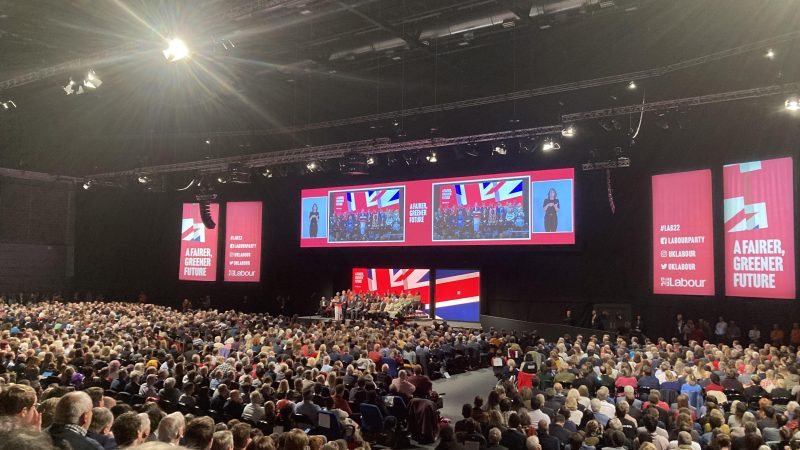
The Labour Party’s annual conference is the one of the biggest political events in Europe. It is Labour’s sovereign decision making body and has a been the seen for many key moments in Labour Party history.
It was an honour to Chair the 2022 Labour Party Conference and serve as an Assistant Chair in 2021 and 2017.
The 2023 Labour Party Conference has over 15,000 delegates, exhibitors and visitors signed-up to attend, with many people attending for the first time. Our internal processes are vital but can look confusing and complicated from the outside, so this is a quick guide to how Labour Party Conference works.
Demonstrating Labour is a government-in-waiting
Labour Party Conference is a high-profile national event and a chance for the party to make its case to the country. The conference can set the new agenda and highlight key policy priorities.
It is a chance for Keir Starmer and his new Shadow Cabinet team to demonstrate to the public that we are serious political party and that they can put their trust in Labour. Keir Starmer, Angela Rayner, Rachel Reeves and the Shadow Cabinet team will make speeches setting out what Labour would do in government, making key announcements as the UK counts down to a general election.
Delegations and voting
Conference delegates come from Constituency Labour Parties, Trade Unions and socialist societies and other affiliates. MPs, Councillors and other representatives can come as ex-officio members, which entitles them to speak in debates. Typically, NEC and NPF annual reports, composite motions drawn up from the motions agreed through the priorities ballot, motions agreed by Women’s Conference and any relevant emergency motions will be debated and voted on by Conference.
Delegations from each section get votes weighted to reflect the size of the body they are representing. A trade union could be representing hundreds of thousands of workers so their votes may outweigh an individual CLP.
Delegates sit in blocks, with Trade Unions usually separate and near the centre so if you are Chairing the session, you can usually easily tell whether a vote has passed on a show of hands. If the show of hands it isn’t clear, the Chair can order a “card vote”, where the delegations then cast their votes from number cards.
Policy-making
Conference has a sovereign policy in determining Labour’s policy agenda. The 2023 Labour Party Conference is probably the last policy-making conference before a General Election. The priorities ballot sees delegates vote on the policy motions submitted by CLPs, trade unions and affiliates that have been approved by the Conference Arrangements Committee (CAC).
The vote takes place at the start of Conference. Motions will grouped by theme. Delegates that put them forward will work together to agree consensus wording through the compositing process. The composited motions are debated alongside the relevant policy debates.
The National Policy Forum (NPF) Policy Commissions held policy consultations early this year, receiving record submissions. NPF members have been discussing and debating policy throughout the year. July’s NFP meeting agreed the policy narrative and direction of travel. The Commissions have produced policy documents that will be debated and voted on at October’s Labour Party Conference. These documents potentially form the basis on Labour’s General Election manifesto. Delegates typically also have the chance to “reference back” sections of the report and vote on Labour’s future policy priorities, though arrangements this year may differ as it could be the last conference prior to the next general election.
A “reference back” lets delegates refer back to a specific section of the NPF policy document. If agreed by a majority of delegates, the reference back asks the relevant NPF policy commission to review this section. References back aren’t an opportunity to make amendments to the policy documents.
Other key internal party votes
Labour holds elections to National Committees at Labour Party Conference. This year delegates will be electing members of the National Constitutional Committee, NEC and CAC. The Labour Party General Secretary and Treasurer make reports to Conference. The Treasurer’s report is an opportunity for delegates to ask questions about Labour’s finances. The CAC produce daily reports, which are voted on. People can ask to reference back the CAC report as well.
Conference also considers “constitutional amendments”, also known as rule changes. The NEC can recommend changes to the Labour Party rulebook for that year. Delegates attending can also put forward rule changes. Rule changes can vary from small administrative changes that tidy-up the rule book, to more radical changes to the way Labour’s processes work. Rule changes are always voted on by card votes.
See you at Conference
I hope this guide was helpful. The Labour Party produces longer guides with more extensive information. The Party Rule Book is essential reading if Labour rules and process is your thing.
I will write another article with tips and advice for visitors and delegates. I have always found Labour Party Conference exciting and inspiring. With a General Election getting ever closer, I am really looking forward October. See you there!




More from LabourList
Lord Hayward: Disappointing May elections could decide Keir Starmer’s fate
LabourList Christmas quiz 2025 round 5: factions and unions picture round
LabourList Christmas quiz 2025 round 4: Christmas Connects